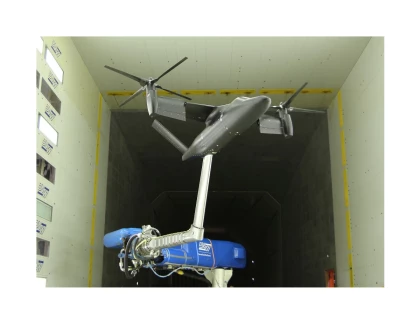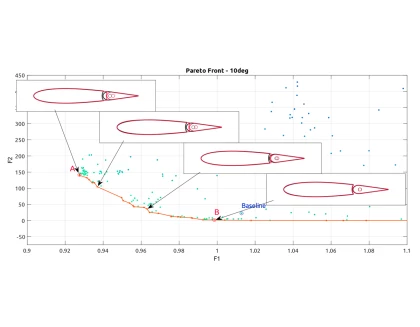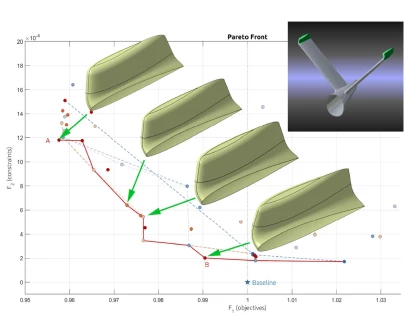
Background
The Next Generation Civil Tilt Rotor (NGCTR) concept aims to deliver superior vehicle productivity and performance than conventional rotorcraft and to fill the gap between traditional helicopters and other fixed-wing platforms. As such, it will contribute to open a new segment of air transport and mobility, in line with increasing demand for flexible and smarter mobility solutions.
In this context, the aerodynamic configuration of the novel tilt rotor NGCTR demonstrator needs to be assessed, with the aim of verifying the main design choices and provide guidelines and proposals for potential additional improvements. A key aspect of the design is the identification of an optimal empennage configuration which needs to be effective in stabilizing and controlling the NGCTR both in forward flight and in conversion mode.
Due to the location of the tail surfaces and the tilting rotors, the area of the empennage features significant aerodynamic interactions with the turbulent wake behind the rotors. The nature of the complex airflow phenomena in that region requires experimental tests on a large, powered wind tunnel model to adequately capture the flow phenomena in various flight conditions. A clear understanding of the efficiency of different empennage configurations (i.e. T-tail vs. V-tail) in terms of aircraft static stability and drag reduction, including the effects of rotor flow, is vital for the validation of the innovative tilt rotor concept.
Strategy
To fully address the scope of the project, a comprehensive wind tunnel campaign was carried out on a powered model of the NGCTR equipped with both T-tail and V-tail, and a CFD-based aerodynamic optimization on the V-tail configuration was performed in parallel, aimed at enhancing aircraft stability and reducing drag.
Regarding the experimental part, an existing 1/5th scale full-span model coming from the previous NICETRIP programme was modified to accommodate the two new empennage geometries (T-tail and V-tail). In addition, a new set of rotor blades with a 40% bigger radius was designed and manufactured to better capture rotor inflow effects over the wings and empennages. A complete powered wind-tunnel campaign was then carried out in DNW-LLF aimed at assessing the relevant flow phenomena in significant flight conditions, featuring different Mach numbers, nacelle angles and rotor thrust values. To this purpose, in addition to classical balance measurements, an innovative visualization technique was used, namely large-scale PIV using Helium Filled Soap Bubbles (HFSB) as particles to visualize, in order to better characterise the flow field in the vicinity of V-tail.
Concerning the numerical activities, a multi-step approach was adopted for aerodynamic optimization of the V-tail, based on the HIT09 optimization platform GeDEA-II. In particular, a preliminary optimization of 2D sections of the empennage was followed by a multi-objective, multi-constrained 3D optimization of the so-called Finlets® (an innovative aerodynamic appendix patented by Leonardo) with the aim of increasing longitudinal and latero-directional stability of the V-tail, while at the same time minimizing drag and lowering rolling moment at the tail root. Subsequently, the tail-fuselage junction was optimized as well, and also the empennage planform was fully characterized using a parametric study, which provided dependencies of the aerodynamic coefficients from root offset, dihedral angle and aspect ratio.
Outcomes
The comprehensive experimental program in the wind tunnel primarily covered the low speed range of the flight envelope, from helicopter mode through conversion to aircraft mode, including parametric variation of incidence and side-slip angle, outer wing and nacelle tilt angles, control surface settings and rotor operating points. The test program concentrated on aerodynamic interactions and tail effectiveness of both T-tail and V-tail. Force and moment measurements on the NEXTTRIP tiltrotor aircraft showed similar airframe lift and drag characteristics for the T-tail and the V-tail configurations in a wide range of flight conditions. A thorough analysis of both longitudinal and lateral stability was carried out with T-tail and V-tail at different Mach numbers, nacelle angles and rotor thrust values, including the effect of the rotors wake. Particular attention was paid to evaluate the low-speed-high-yaw-pitch-up phenomenon that can affect some designs when the tail region is immersed in the rotor wake.
The PIV-HFSB technique was tested successfully up to 60 m/s with a 3×3 seeding rake and it provided excellent flow visualizations, as HFSB are lighter and larger than the conventional particles with the potential to neutral buoyancy and enhanced light scatter.
Three sets of numerical optimizations were conducted on 2D V-tail sections at different ruddervator deflection angles. A reduction of 0.2% in drag coefficient was achieved in cruise with a simultaneous significant improvement of hinge moment at near-stall conditions. Also, a significant improvement of the derivatives of the lift coefficient was achieved both in cruise and near-stall conditions (+4.08% and +0.67% respectively).
Regarding the Finlets® optimization, a maximum decrease in drag coefficient of 0.79% was obtained with respect to the baseline with a simultaneous reduction in the rolling moment coefficient equal to -6.84% at cruise and -4.42% at near-stall conditions) and pertinent acceptable reduction of yawing moment derivative.
Duration: March 2018 - August 2020
This project has received funding from the Clean Sky 2 Joint Undertaking (JU) under grant agreement No. 785350










